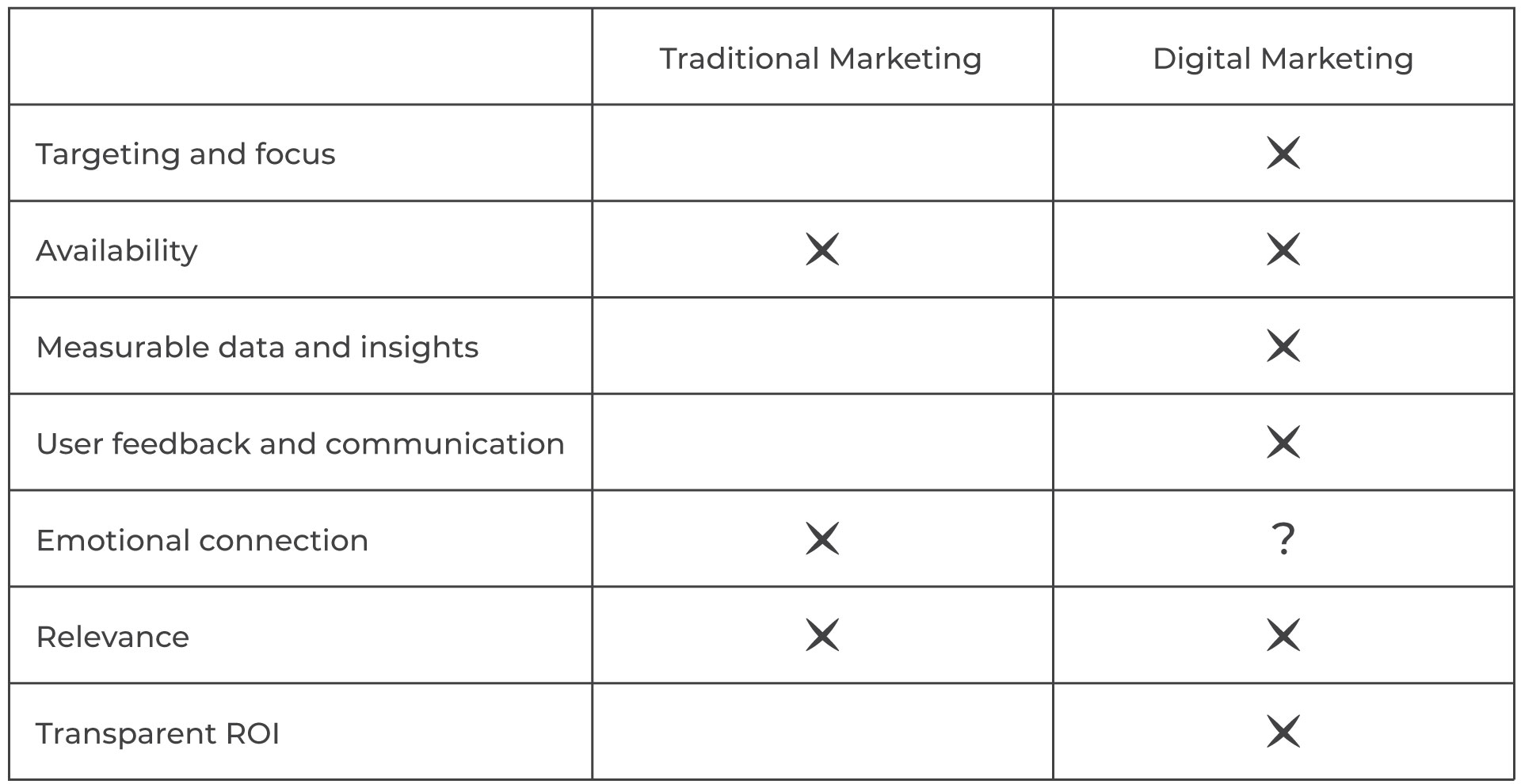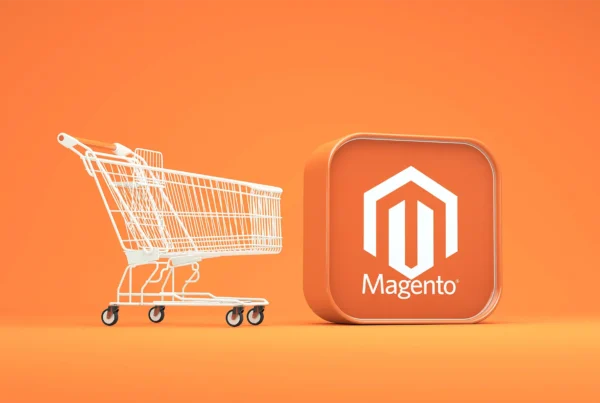Whether you own a small startup or work at an established corporation, every business needs marketing. Over the years, marketing platforms have shifted, and with that shift, we need to update our approach to marketing and rethink the marketing strategies we’ve grown accustomed to.
When considering which route to take, choosing between either traditional marketing vs digital marketing, there are many factors to consider. If you’re not experienced in the field, it can get a bit tricky. We know better than anyone that the ins and outs of marketing can be complex and for that reason, we decided to write this article to help explain some of the pros and cons of these two forms of marketing.
Stick with us as we break it down.
What is traditional marketing?
We’ve grown up with traditional marketing (right? Or am I just old?) and know how to recognize it easily. It’s often very obvious and in your face, which is part of its effectiveness and charm. And although it has evolved over the years based on user habits, one thing has remained true: throw a stone, hit an ad.

Perhaps the best real-life example of traditional marketing would be walking down Times Square in New York City. The glow of brightly lit billboards screams down at the mass of passersby, while the posters in the shop windows call out to you with their latest sale. As you continue on your walk, a young man is handing out pamphlets, encouraging you to take a break and grab a slice at the nearby pizza joint.
This is traditional marketing in all its glory.
Pros of traditional marketing
Now that we’ve covered what traditional marketing is, let’s talk about some of the pros of this somewhat dated, yet tried and proven method of communicating your message. One of the biggest pros is its physicality.
Whether you’re driving to work, flipping through a magazine at the doctors’ office, or out on the town with friends, you’re bound to run into some form of traditional marketing. If your bartender hands you your drink with a Bud Light coaster, you’ve been targeted by traditional marketing.
You may or may not then order a Bud Light as your next drink, but the power of traditional marketing lies in mass communication and “in your face” brand messaging. The more widespread the communication, the more you’re led to believe that this brand is global and established. After all, you were just handed a Bud Light coaster, not an Icehouse coaster! And if you don’t know what an “Icehouse” is, you’re just proving my point.
Another pro of traditional marketing is its ability to link a brand or product to an emotion. Unlike digital marketing where most information is consumed and limited to a few main platforms, associating a certain brand to an event or location has tremendous power when it comes to positioning.
As an example, let’s go back to our trusty Bud Light (I swear this is not a paid ad!). This beer is not normally portrayed or consumed as a high-end beverage. You may see examples of traditional marketing for this particular brand at a ball game, on a banner at the supermarket, or on TV during halftime.

Now think of Moet and Chandon, going to the opposite extreme. We wouldn’t see any advertising at a ball game but perhaps would see an ad displayed at the Oscars red carpet or at a golf event. Linking your brand to a particular status or social standing can have an important effect on the concept and placement.
Cons of traditional marketing
Have we tooted the traditional marketing horn enough? Ok, now for the cons.
One major con of traditional marketing that every “marketeer” will agree on is the lack of transparency regarding the exact result your campaign has had. It’s hard, almost near impossible, to know the true impact your billboard or tv commercial has had on your target audience, and the number of sales it drove. Traditional marketing is often a longer, slower process of building brand power and relevance with your consumers, and oftentimes a particular campaign can’t claim an exact number of sales.
To build on the above point, con number 2 is that this marketing method relies heavily on location. Whether it is effective or not is in direct correlation with how many people are physically in the location where you’ve decided to advertise, be it a billboard, bus stop, tv or radio commercial, sponsored events, flyers, branded cups and coasters at your local bar, and the list goes on.
That brings us to our final con: not knowing exactly who will see your ad. When posting a billboard or sponsoring a tv commercial, while you can segment it to a certain extent, there is no measurable way to know how many people saw it, how many of those are your target audience, and which of those were interested in your advertisement and bought.
I hope you see where I’m going with this — that’s right, I’m setting you up for the wonders of digital marketing’s segmentation, insights, and reporting.
What is digital marketing?

As technology has progressed, so has the interest of the public and the platforms they spend the most time on. Every other meme out there jokes about how this generation can’t stand the thought of leaving their homes and instead prefer to spend all their time scrolling through Instagram, and so marketing professionals have shifted their focus to more relevant communication channels.
We all know and love Facebook, Instagram and Twitter and work to stay up to date and current on all the latest news, celebrity gossip, and personal relationships via these platforms. We also jump to Google when wanting to prove a point or search for ideas for where to take a hot date or order takeout.
When completing any of the above-mentioned actions, you’re likely to stumble across some form of online marketing and, as bewildering as we all find it, ads for that very thing in the days and weeks to come.
Pros of digital marketing
Pros of digital marketing, my dear, why there are many! The ability to target the exact person who would be interested in your product and adapt your messaging to resonate with that particular individual or group versus another is a tool you’d, frankly, be foolish to not use. In fact, I bet I could target my own mother with a well thought out and placed ad…and she’d buy it, too!
The unparalleled insight we have in digital marketing is the most powerful tool at any brand’s disposal. With the targeting available to us, we can narrow down our audience as specific or as broad as we want, target users by interests or location, and even create a “look-alike” audience to target users who behave like our current customers.

And then, once that ad has run, we can see exactly who bought, where they are, their gender, age range, interests and more. Each sale can be directly attributed to the campaign and as marketers we can, as Beyonce says, “walk like this cuz I can back it up”.
As big brands and companies are beginning to realize the importance of consumer-centric marketing plans, hearing back from your consumer and establishing a connection with them is more important than ever. Major market studies to analyze consumer behavior and feedback will soon be a thing of the past with online surveys, social media reviews and recommendations, and even apps like Yelp, we can quickly know exactly what our customers think of the product and brand messaging, as well as other aspects such as customer service delivery and more. This is a huge asset when it comes to adapting and tweaking your processes to better serve your consumer and improve your brand perception.
One more amazing pro is the accessibility that directly links your customers to your product. If a social media user sees an ad, they have the ability to buy it right then and there. When flipping through a magazine and seeing an ad, the customer may like what they see, but after they set the magazine down, they may never actually remember to buy the product when they’re at the mall. You’ve now lost a sale, and with digital marketing, it’s easier to prevent those sales from falling through the cracks.
With all these amazing aspects and functions, you’d wonder if there are any cons to digital marketing. Surprisingly, there are a few. We’ll delve into them below.
Cons of digital marketing
The internet moves fast and so do our brains. Nowadays, consumers are over-stimulated and constantly bombarded with information and interesting things to look at and take in. In order to keep up with this pace, the messaging, concepts, and creatives have to adapt.
A well thought out campaign today involves well-researched segmenting, eye-catching ad creatives, and a clear CTA in the header, whereas a “good” traditional marketing campaign back in the day was more, well, the Marlboro man. Need I say more?
The problem is that many brands sacrifice quality for clickbait.
This fast-paced take on marketing sacrifices the ability to create a concept that will be as relatable with a consumer. There is no time to allow the user to slowly immerse themselves in the concept and place themselves in the concept you’re creating. Instead of conveying the value of a product and selling it to your audience based on an emotion or concept, we’re just putting the product in their face over and over again, offering a value add that, once again, doesn’t tell the consumer why they want the product and what kind of feeling they’ll have while wearing this particular brand.
Difference between digital marketing and traditional marketing

We’ve talked about both forms of marketing extensively, but who doesn’t like a clear, well put together table of all of the important elements we analyzed above?! A quick look at this chart shows a clear difference between digital marketing and traditional marketing and, that in this day and age, taking into account the needs and preferences of this current generation and all the tools available to us, we have a clear winner.

Advantages of digital marketing vs traditional marketing
So there you have it! We hope that this article was helpful to you and that now you fully understand the advantages of digital marketing vs traditional marketing and are able to make an informed decision about how to proceed for your business. Taking all factors into consideration is important when designing your marketing strategy, and armed with the information in this blog, you’ll be able to more consciously build the ideal campaign for your business, audience, and product.
We know that there are so many things to keep in mind: what platform is the best for your audience, how to create a successful social media ad, how do I get listed on google, and the list goes on.
The good news is that we’ve been in this business for years now, and survived quite a few algorithm changes and are confident to say that we will be happy to consult you on the subject to help you reach your online marketing goals and set you up for success.
If you’re ready to start getting incredible results, engage your audience, and get your message out there, fill out the form below and we’ll set up a call to get you started!





